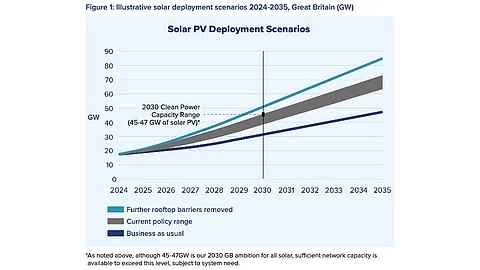

The UK has released its Solar Roadmap to achieve the Clean Power Action Plan target of up to 47 GW by 2030
It can exceed this target with helpful policy measures, especially with the help of rooftop solar
It can double the number of direct and indirect jobs in the solar PV industry to 35,000 by 2030
The UK government has launched its long-awaited Solar Roadmap, outlining a clear strategy to rapidly scale up solar power deployment and boost energy security. Developed in partnership with the industry over the last 2 years, the roadmap supports the UK Government’s Clean Power Action Plan, which aims to raise solar capacity from over 18 GW as of Q1 2025 to 45–47 GW by 2030, and even exceed it.
“The Clean Power Action Plan identifies that 45-47GW is our ambition for all solar by 2030, but it also confirms there is grid capacity available for up to an additional 10GW, should the system need it,” said Solar Energy UK (SEUK) CEO Chris Hewett. “To maximise the chances of achieving the clean power targets, the solar industry will be aiming to deliver at the top end of the country’s needs.”
As per the plan released by the Department for Energy Security and Net Zero, achieving up to 47 GW capacity will require only up to 0.4% of the total UK land. An additional 9 GW to 10 GW can be added as smaller-scale rooftop solar projects, subject to Transmission Impact Assessments (TIA), before 2030. Hence, the country could be looking at around 57 GW of total capacity by the end of this decade.
One of the biggest benefits of solar, as identified in the roadmap, is the speed of deployment. Construction of a large-scale solar project can take as little as a year, while rooftop solar is even quicker. This can help the country reduce its dependence on volatile fossil fuel markets.
“More than 1.5m homes across our country now have solar installed, and since this government came to office my department has consented almost 3GW of nationally significant solar projects – nearly 3 times as much as the previous 14 years combined,” said the UK’s Secretary of State for Energy Security and Net Zero, Ed Miliband. “But we know we need to go further to deliver our goals for clean power by 2030 and beyond.”
The report envisions various scenarios to ascertain the solar PV potential in the UK. Business as usual (BAU) scenario estimates the country to install up to 30 GW solar PV capacity by 2030, expanding to between 45 GW and 50 GW by 2035, well below the Clean Power Action Plan targets.
The current policy range with favorable economic and infrastructure conditions can boost deployment under the current policy to the target of up to 47 GW by 2030, and 75 GW by 2035. Of the capacity installed by 2030, around 60%-65% could be large-scale projects, around 20% domestic rooftop and around 15%-20% commercial rooftop and ground mount (see UK Targets Up To 47 GW Solar PV Installed Capacity By 2030).
Removing further rooftop barriers can increase the rooftop solar capacity to around 10 GW and commercial rooftop and ground mount to more than 10 GW by 2030. Under this scenario, by 2030, the total PV capacity can exceed 50 GW and further expand to around 85 GW by 2035.
This includes helpful measures such as removing barriers for commercial rooftop such as removing the planning permission requirement for over 1 MW commercial rooftop systems, and in the form of the Future Homes Standard (see New UK Homes To Have Solar Panels ‘By Default’). This doesn’t include the helpful role other policies, such as the Warm Homes Plan and Great British Energy, can play.
Boosting solar deployment can support up to 35,000 direct and indirect jobs in Great Britain by 2030, as per the assessment, double the number it supports today.
The roadmap also looks at the supply chains for solar. The government says it is committed to ensuring that these are free from the use of forced labor (see UK Wants Forced Labor-Free Solar Supply Chain).
Moreover, it seeks innovation in the space to use this ‘once-in-a-generation’ opportunity to establish a solar supply chain and manufacturing capacity in the country.
“While the UK is unlikely to be able to compete in the existing global market for conventional solar panels, there is scope to grow industries producing balance of system components (broadly all components apart from solar panels), creating opportunities for key industries like steel. Other areas with potential include innovative panel applications, storage, and services,” reads the report.
The government is also in the process of establishing standards for next-generation solar technologies to help cut costs for UK manufacturers exporting to other nations.
The roadmap’s progress will be monitored and evaluated by the Solar Council, a new forum that will be jointly chaired by Michael Shanks MP, Parliamentary Under Secretary of State for Energy Security and Net Zero, and Chris Hewett, CEO, Solar Energy UK. It will meet thrice a year.
The complete Solar Roadmap of the UK is available for free download on the government website.
